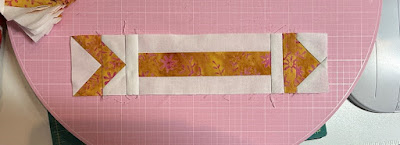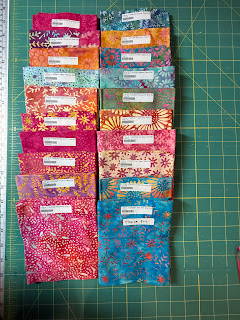Hello Everone!
Some fun and easy blocks to make this week. We are making the Heart Block, the Checkerboard Border blocks and the Heart Cornerstone blocks.
We will start with the Heart Block which is super easy. As we have to make (4) blocks, we can use some shortcut methods that will give us all our units at once. We will be making 8 at a time HST units and 4 at a time flying geese. Here is my fabric cut.
WOF - Width of Fabric HST - Half Square Triangle QST - Quarter Square Triangle
RST - Right Sides Together
Background: Cut (3) 2 1/2" x WOF. Subcut (16) 2 1/2" x 6 1/2" rectangles (sashing)
Cut (1) 8 1/4" square (for HST units)
Cut (1) 2 1/2" x WOF. Subcut (8) 2 1/2" squares (for geese units)
Mini Daisy Pink Valetine: Cut (2) 2 1/2" x 22" Subcut (16) 2 1/2" squares (for cornerstones)
Petals Red Salmon: Cut (2) 1 1/2" x 22" Subcut (4) 1 1/2" x 6 1/2" rectangles (for center)
Cut (2) 4 1/4" squares (for geese)
Cut (1) 8 1/4" square (for HST units)
HST Units Eight At A Time:
Step 1: Gather the 8 1/4" background square and Petals Red Salmon square. Place RST with
the background square on top. Using a ruler, draw a diagonal line from corner to corner
both directions or use your magic wand to create sew lines.
Step 2: Sew your seams in both directions. It should look like a 'double X' once sewn. Using a
ruler, cut between the sew lines in both directions. Do not move any pieces yet. Take
your ruler and cut horizontally though the center, then vertically through the center.
This is much easier to do without moving your parts if you use a rotating cutting mat.
Step 3: You now have (8) HST units. Press (4) of the units to the Background fabric and (4) of the
units to the Petals Red Salmon fabric. This way our HST units will nest together. Square
your HST units to 3 1/2" using your favorite method. We will be using two for each heart
block. I used my Studio 180 Tucker Trimmer I.
You now have (8) 3 1/2" unfinished (3" finished) HST units.
Flying Geese Four At A Time:
Step 1: Next gather the 4 1/4" Petals Red Salmon squares and the (8) 2 1/2" Background squares.
We need a total of 8 flying geese (2 per block) and each square is going to give us 4 units.
Step 2: Place (2) 2 1/2" background squares RST on opposite corners of a 4 1/4" Petals Red
Salmon square. They will overlap in the center. Nudge these in a little bit from the edge,
roughly a 1/16" or so. It helps us with a little fudge factor space. Draw a line diagonally
from corner to corner crossing both background pieces. Slip a pin in to make sure they
don't move when your are sewing them. Sew 1/4" to each side of the line. Cut in between
your seam lines.
Step 3: Because we will need our geese to have nested seams when sewn together, we need to
press away from the triangle for this first step and toward the Petals Salmon Red fabric.
Make sure your press straight and do not distort the fabric.
Step 4: Next we place another Background square on the new units we have created, nudging in
again about that 1/16th" from the edge. Draw a line, then sew 1/4" to each side. Cut
between the seams then press to the Backround fabric (to the triangle).
Step 5: Each of tour geese should now have one wing pressed in and one wing pressed out.
Our geese need to be squared to 2" x 3 1/2". I used the Studio 180 Wing Clipper ruler.
Sashing Units:
Step 1: Next we can add our cornerstone squares to the top and bottom block sashing pieces
so they will be ready to use. Gather (16) Pink/Red 2 1/2" squares and (8) 2 1/2"
x 6 1/2" background rectangles. I like to chain sew for efficiency whenever possible and
this is a great place to do so. Place a Red/Pink square RST on a background rectangle.
Line up the edges and sew using a 1/4" seam. Repeat this for all 8 units. Do not cut the
chains yet. Simply turn the last piece in the machine around and sew squares to the
remaining end. Press all seams in toward the background fabric.
Heart Block Assembly:
Step 1: Now we can assemble the blocks. Sew (2) Geese units together nesting the seams. Press
the seam to the right.
Step 2: Sew the 2" x 6 1/2" Petals Red Salmon piece to the bottom. Press to strip.
Step 3: Sew (2) HST units together nesting the seams. add these to the bottom of the assembly
from above. Press to the center strip.
Step 4: Sew a 2 1/2" x 6 1/2" background strip to each side. Press to the sashing strip.
Step 5: Sew a sashing strip with cornerstone units to the top and the bottom. Press the seams out
to the sashing strips.
Square your blocks to 10 1/2" as needed. (4) Heart Blocks Made
Border Checkerboard Blocks
Background: Cut (5) 2 1/2" x WOF. Cut in half to get (10) strips approx 22" long
Cut (4) 1 1/2" x WOF (checkerboard border sashing)
Mini Daisy Pink Flamingo: Cut (5) 2 1/2" x 22"
Sprig Small Daisy: Cut (5) 2 1/2" x 22"
Step 1: Make strip sets using the 2 colors and the background strips. Press all seams to the darker
color. Be careful when pressing not to distort your fabric or add a bow to the stripset. It
should be nice and straight. It should measure 4 1/2" x 22" approximately.
Step 2: Cut 2 1/2" wide units from each strip set. You will have (40) of each color combination.
Step 3: Sew the 2 1/2" units together as shown below. You will have (10) each of blocks that start
with opposite colors.
Press seams in for the ones that start with background (top one in picture)
Press seams out for the ones that start with a colored square (bottom one in picture)
NOTE: This is an update. Instead of sewing the individual 1 1/2" strips, sew the checkerboard border pieces together first, measure then cut the 1 1/2" x WOF sashing to size. In a perfect world, this measures 40 1/2". Press out to the background strip. Each checkerboard border has 2 each of the blocks. Rows always start with a checkerboard block that has a solid color top left. Blocks alternate.
Cornerstone Heart Blocks:
Our final units for this week are the Cornerstone Heart Blocks. These are super simple as well. We are making HST units and some simple folded corner units.
Background: Cut (1) 3 1/2" x WOF Subcut (4) 3 1/2" squares (HST units)
Cut (1) 2" x WOF Subcut (8) 2" squares and (8) 1 1/2" squares (Folded Corners)
Medium Daisy Multi: Cut (4) 3 1/2" squares, (8) 2" x 3" rectangles, (8) 1 1/2" x 3" rectangles
Step1: Place the 3 1/2" Baclgrund square on top of the Medium Daisy Multi squares RST. Draw
a diagonal line corner to corner and sew on either side of the line or use your magic wand
to create sew line.
Step 2: Cut in half bewteen the stitch lines and press (4) to the Background fabric and (4) to the
Multi Daisy fabric so that our seams wll nest.
Step 3: Square to 3" square. (8) HST units made.
The upper part of the heart is made with two different size folder corner units. Gather the rest of your pieces.
Step 1: Draw a diagonal line corner to corner on the back of all the Background 2" and 1 1/2"
squares. The drawn line is the sew line.
Step 2: Line up the squares on the corners of the corresponding side rectangles. We need
opposites so be certain to check that you have (4) of each with the diagonal line running
left to right and (4) that are right to left.
Step 3: Sew ON the diagonal line. trim the seam allowance to 1/4". Press the seam on half to
the Background fabric and on half to the Medium Daisy Multi fabric so that our seams
will nest.
We are now ready to se our blocks. Layout your units in order.
Step 4: Sew the HST units together and press the seam to the right.Step 5: Sew the upper folded corner units together in pairs of a small unit and large unit,
making sure the seams nest.
Step 6: Sew the units from Step 5 together and press the seams to the left.
Sew this to the top of the HST assembly from Step 4. Press the seam up toward the
folded corner units. Square to 5 1/2" as needed. Make (4) Cornerstone Hearts.
We now have all our main blocks completed. Next week we will make the Arrow Border and assemble our quilt. If you would like to get a jumpstart on the row assembly, simply sew the blocks in rows as per the quilt image below starting and ending each row with a Checkerboard Block. Alternate the pressing of the seams on each row so that seams will nest when joined.


























































